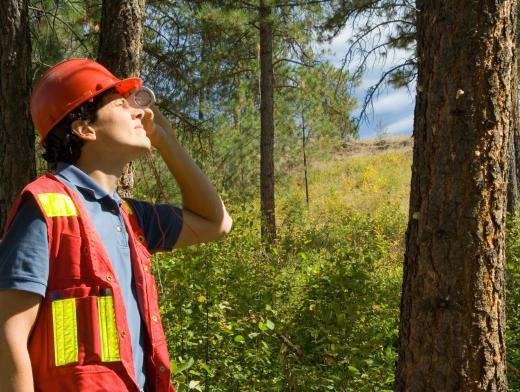Students and specialists in the forestry, tree physiology, and forest ecology sectors often have to measure tree growth. To do this, they usually use a dendrometer, or special measuring band. Also known as D-tape, diameter tape is a type of dendrometer used to measure tree diameter.
Diameter measuring tapes are usually made of cloth or metal, and calibrated in units of 3.14, or an estimation of the unit pi, inches or centimeters. They are generally used to measure a tree's diameter at breast height. This is considered to be four and a half feet (137.16 centimeters) above ground. Measuring the diameter at breast height prevents the measurer from calculating the width of the tree's base, which would reflect an inaccurate diameter of the overall tree.

Though diameter tape actually measures the circumference of a tree, it easily converts to diameter. This is because circumference and diameter are related by pi. However, diameter tape does not provide completely accurate measurements, as it is assumed that the tree's inner cross-sections are made of perfect circles. Any values obtained are therefore considered an approximation.
To measure a tree, the tree stem must first be prepared prior to using the diameter tape. The surface should be free of knots, branches, or other obstructions. The circumference where the tape will be used should be sanded with a file or sandpaper. Care should be used during this process to avoid damaging the tree.
A person should make sure the diameter tape is at breast level. The tape should be perfectly level, without any kinks or twists in it to ensure the most accurate reading. The diameter side should be up, facing the measurer. When the number zero aligns with the end of the tape, the diameter is able to be read off the tape.
After taking the measurement, the circumference can then be converted to diameter. This is done by dividing the circumference by the approximation of the unit pi, 3.14. Mathematicians will recognize the use of the equation for circumference to solve for diameter.
Appraising the diameter of a tree in conjunction with its height is important to detect the tree's wood volume. During the tree's sale for pulp, lumber, or other purposes, its volume is necessary for proper pricing and use. To estimate the volume of wood in standing trees, tree volume tables are used. Displaying average diameters and heights, these tables list diameters along a matrix to portray a quick visual display of wood volume.

